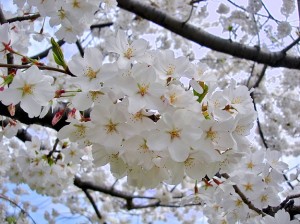Have you spent time in a scented garden? Enjoyed its fragrant perfume yielded by trees, shrubs, flowers, and bulbs? Have you sat and listened to the chorus of songbirds, or wondered why there were so many pollinators and desirable wildlife? A fragrant garden is a host to many visitors who want to enjoy the many pleasures it offers.
 Scented gardens have been enjoyed throughout history, and have been popular for many years and throughout many parts of the world. The hanging gardens of Babylon were thought to have been a scented garden. These gardens are usually designed with their individual fragrances in mind. Light scents are preferred, and bulbs such as daffodils, narcissus, hyacinths, snowdrops, irises, and lilies are popular selections.
Scented gardens have been enjoyed throughout history, and have been popular for many years and throughout many parts of the world. The hanging gardens of Babylon were thought to have been a scented garden. These gardens are usually designed with their individual fragrances in mind. Light scents are preferred, and bulbs such as daffodils, narcissus, hyacinths, snowdrops, irises, and lilies are popular selections.
Fragrant trees are used as focal points, and add a majestic quality to the garden; their branches supply rest for songbirds, and give shade and shield plants from harsh sunlight and summer heat. A comfortable bench or seat may lure the visitor to sit and bask in the many pleasures the garden affords. Some favorite aromatic trees include the lilac, flowering apricot, southern magnolia, flowering cherry, flowering crabapple, butterfly magnolia, Sweet Michelia (a sweet-scented tree that blooms from late winter through spring) and Chinese fringe tree.
Shrubs also play their part in the perfumed garden: the elegant daphne, splendid gardenia, the sweet mockorange, viburnum, and sweet olive, are grown for their scents. Fragrant shrubs can be planted by doors and windows to bring soft aromas inside the home.
Other attractions, such as the shrub lilac (Miss Kim), honeysuckle, and jasmine are often placed by decks or patios to add enjoyment to outdoor spaces.
The Japanese used fragrant trees to enhance the enjoyment and aromatic quality of their strolling gardens as well as their courtyard gardens. Many have become favorites, which makes them common selections in a variety of areas. The Yoshino flowering cherry tree is among these favorites, blooming throughout the spring into summer. The Japanese plum tree and styrax (or Japanese snowbell) are two whose fragrances are popular picks for a scented garden. The boxleaf azara, a Chilean native with pom-pom-like blossoms, finds its way into fragrant North American gardens. Some who have chosen it claim the scent is similar to white chocolate.
Most garden lovers will add roses; some that I have seen are Cressida, (pink/apricot) Crimson Glory (red), Heritage (pink), Perfume Delight (pink), Mrs. John Laing (pink), Lady Banksia (single white) and Mr. Lincoln (deep red).
Clematis, Jasmine and wisteria are vines that add dimension to a garden, trailing on a trellis, fence, or arbor.
In one garden I visited, a bench becomes a sitting spot in this outdoor room. Behind the bench, on a series of trellises painted blue, are vines of confederate jasmine to place the sitter in a lovely aromatic room. The garden is enclosed with a boxwood parterre, and visitors can find themselves sharing tea and cookies with the garden owner beneath a flowering cherry tree while blue hydrangeas grace the backdrop. It is a feast for the senses.
In colonial days, herbs were placed in gardens for their culinary and medicinal purposes, and many were placed next to the house to give off their aromatic perfumes both outside and inside. These may have included rosemary, thyme, chamomile, dill, savory, marjoram, various mints, and lamb’s ear. These popular choices are still found in modern-day gardens. Some herbs such as lavender had a variety of uses, including perfuming the home (sachets) and scenting the bath water.
The English and French designed their grounds to be enjoyed seasonally, and included a variety of evergreen plants in the designs. These were chosen for aromatic properties. In some areas, conifers planted on walking paths were chosen to give a scent to the garden in winter. Other winter bloomers are witch hazel, viburnum bodnantense ‘Dawn,’ winter daphne, and honeysuckle lonicera fragrantissima, which can be placed in gardens to optimize their fragrances.
Scented gardens draw songbirds, butterflies, bees and other pollinators attracted by the varying perfumes. Azaleas, flowering quince, hawthorn, tulip magnolia, and rhododendron are great choices. Flowers, including dianthus, phlox, nicotiana, clematis, oriental lily, sweet pea, lily of the valley, french violets and wallflower (to mention some of my favorites) grace the garden with color and perfume. Heliotrope, sweet alyssum, peony, moonflower, flowering peach, cherry, star magnolia, black locust and citrus trees are also chosen to delight the senses and perfume the air in the scented garden.
Scented gardens are more becoming popular in in today’s urban areas as courtyard gardens. Private gardens have always enjoyed them, and with today’s interest in gardens, public gardens are also adding scented areas. Some are grown as gardens for the blind, and hospitals are designing scented gardens for their healing properties.
A scented garden is easy to grow, and most of these plants grow very well in this area.



Comments on Chapelboro are moderated according to our Community Guidelines